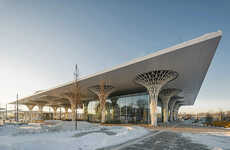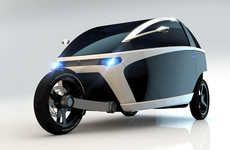
This Tokyo Train Station Was Redeveloped into a Large Open-Air Space
Christopher Magsambol — November 16, 2015 — Eco
This Tokyo train station serves as one of Japan's busiest transportation hubs, connecting city workers to nearby towns and suburbs. To accommodate increasing commuter numbers, a renovation of the existing station was needed.
The newly refurbished station now sits elevated over a parallel street, allowing for commuter access from the ground, underground, east and west of the station. The station services commuter trains as well as a high-speed rail. The open-air redesign now allows for an abundance of space, waiting areas and access to nearby retail spots.
At each end of the Tokyo train station are two tall office towers. At night, these towers are lit, which helps to illuminate the station. The towers have been designed so facades are used to divert airflow into the station, filling it with a constant flow of air.
The newly refurbished station now sits elevated over a parallel street, allowing for commuter access from the ground, underground, east and west of the station. The station services commuter trains as well as a high-speed rail. The open-air redesign now allows for an abundance of space, waiting areas and access to nearby retail spots.
At each end of the Tokyo train station are two tall office towers. At night, these towers are lit, which helps to illuminate the station. The towers have been designed so facades are used to divert airflow into the station, filling it with a constant flow of air.
Trend Themes
1. Open-air Station Design - Disruptive innovation opportunity: Redesigning transportation hubs with open-air concepts to enhance commuter experience and create more space for retail integration.
2. Multimodal Connectivity - Disruptive innovation opportunity: Creating transportation hubs with seamless integration of different modes of transport, such as commuter trains and high-speed rail, to improve efficiency and connectivity.
3. Sustainable Infrastructure - Disruptive innovation opportunity: Incorporating sustainable design elements in transportation hubs, such as utilizing building facades to divert airflow and improve ventilation, to reduce energy consumption and enhance environmental sustainability.
Industry Implications
1. Transportation - Disruptive innovation opportunity: Integrating cutting-edge technologies and design concepts in transportation infrastructure to create more efficient and seamless travel experiences.
2. Retail - Disruptive innovation opportunity: Leveraging transportation hubs as prime locations for retail integration, creating convenient shopping experiences for commuters and generating additional revenue streams.
3. Architecture/urban Design - Disruptive innovation opportunity: Exploring new approaches to architectural and urban design to transform traditional transportation hubs into vibrant, open-air spaces that enhance urban connectivity and livability.
2.9
Score
Popularity
Activity
Freshness























